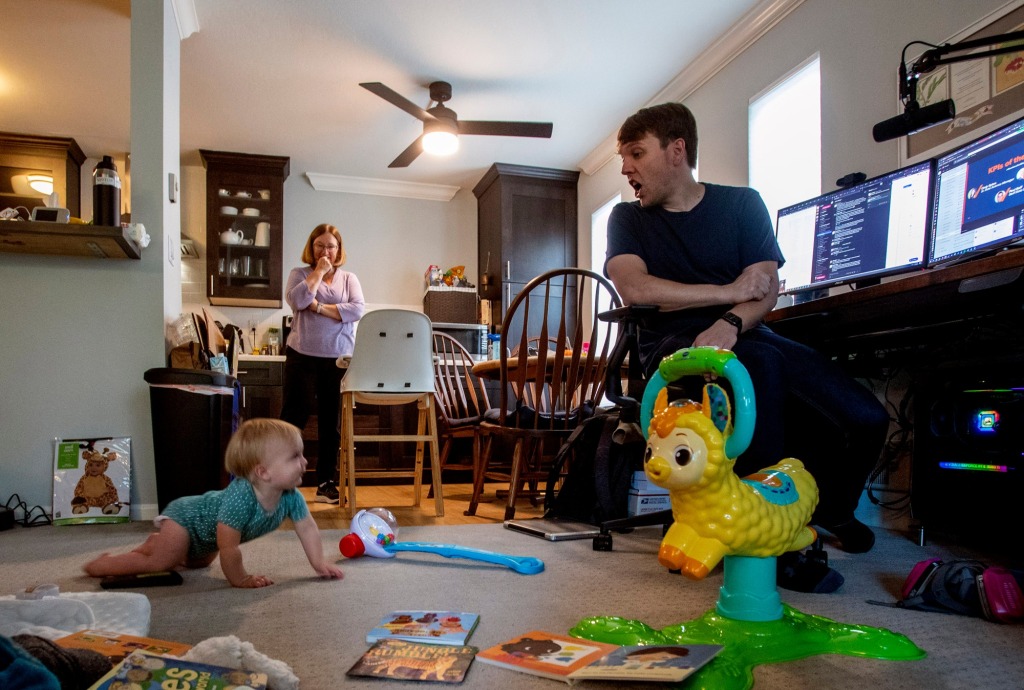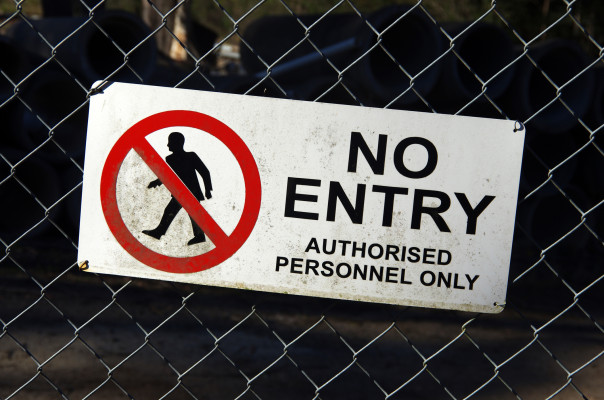Phillip Parent, a tech worker, used to get miffed when colleagues had work-from-home schedules. Why, he thought, should they get special treatment?
The Bay Area native worked the Silicon Valley office grind: “We got in early, we left late.”
Then COVID-19 struck, offices snapped shut and Parent began managing IT support work from his San Mateo apartment.
After more than a year-and-a-half at home, and major life changes and milestones — switching jobs, starting a family, working on the couch in pajamas with his daughter — he’s changed his mind about where he works. He loves the choice of working from the office or home.
Parent, 34, and his wife even started to discuss leaving the Bay Area while holding on to their Silicon Valley careers. What once seemed impossible, he said, might now be possible: “It’s kind of opened the door.”
The COVID-19 pandemic has revolutionized work in a way few expected. Office workers have shunned offices, and once-vital career building in Bay Area tech HQs has given way to a new demand: We don’t want to go back to the way it was.
Liberation from vexing commutes and tight cubicles are freedoms Silicon Valley workers are extremely reluctant to give up: 70% of those able to work from home now want to stay out of the office most, if not all, of the time once the pandemic is over, according to a recent poll by the Bay Area News Group and Joint Venture Silicon Valley. Just 2% said they never want to work remotely.
The old and rigid corporate way of conducting business face-to-face has been disrupted, but how much and for how long remains uncertain, said Santa Clara University business professor Jo-Ellen Pozner. Bay Area companies have been constantly adjusting pandemic work rules and pay structures for remote employees, she said.
“It’s still shaking out,” said Pozner, an assistant professor of management. “It will take a little while to get reoriented.”
 But the shift to telecommuting has been seismic: nationally, just 1 in 5 remote workers told the Pew Research Center they worked from home before the health crisis. By last October, nearly 38% could do their jobs remotely and a little more than half wanted to continue that after the pandemic ends, Pew found.
But the shift to telecommuting has been seismic: nationally, just 1 in 5 remote workers told the Pew Research Center they worked from home before the health crisis. By last October, nearly 38% could do their jobs remotely and a little more than half wanted to continue that after the pandemic ends, Pew found.
Bay Area workers are even more likely to be able to work remotely with 48% saying their jobs can be done from home. And among tech workers, 72 percent said their jobs could be done remotely, the Bay Area News Group poll found.
Russell Hancock, CEO of Joint Venture Silicon Valley, said the reluctance to give up remote work is “a really major finding.”
Hancock said the pandemic has made people shift priorities, focusing more on family and community and not exclusively on career. “Everybody made their own discovery,” he said.
But many haven’t been able to embrace the new flexibility. Employees tied to job sites — service workers, health care providers, laborers — often had to choose between accepting health risks or losing wages.
The pandemic exacerbated the Bay Area’s broad divide between haves and have-nots, Pozner said. Many remote workers have moved to low-cost regions, while other lower-paid employees remain mired in regular Bay Area commutes, high rents and living expenses.
“Now the people in privileged positions,” Pozner said, “are putting themselves in a more privileged position.”
The most dramatic split between the Bay Area’s remote and nonremote workers occurs in education and wages: 6 in 10 remote employees have at least a college degree and are far more likely to take home higher wages while 8 in 10 of those earning less than $50,000 cannot work remotely, according to the survey.
Many nontech employees feel they have little choice in work decisions.
Spencer Von Glahn, 30, works as a contract security consultant for the federal government. Days before he was scheduled to deploy to a foreign post in March 2020, his contract was canceled due to pandemic precautions.
“I lost a few months of work,” said Von Glahn, who served six years in the Marines. He spent the time with his fiancée in their Hayward apartment, mostly bored and waiting for his next job. “I would have kept working if I had my way.”
Erina Nayfeld owns a medical supply shop in San Francisco’s Richmond District. She could not work remotely — her dedicated customers, mostly elderly Russian immigrants, needed regular supplies. And Nayfeld, 63, needed to pay the rent. A couple of weeks into the pandemic, she started going to the store, taking orders and delivering equipment.
The pandemic sharpened Nayfeld’s belief about her retail business: “It’s human touch and connection,” she said. “People need each other.”

 Many professionals, however, have gained leverage, and companies have responded. In a monthly survey of 200 large and mid-sized companies, the Bay Area Council found that about 70% expect to bring back workers between two and four days a week. Just 20% say they want to return to full-time office schedules.
Many professionals, however, have gained leverage, and companies have responded. In a monthly survey of 200 large and mid-sized companies, the Bay Area Council found that about 70% expect to bring back workers between two and four days a week. Just 20% say they want to return to full-time office schedules.
Workers say the major benefits of working remotely are less commuting (80%), safety from the virus (63%), more flexibility in choosing when to work (59%), and the overall comfort of staying home (55%). Nearly half said they are more productive away from the office. But they acknowledge tradeoffs: more than half said a sense of community at work is a reason they’d go back and 49% said they can collaborate better on-site.
The Bay Area has lagged behind New York, Los Angeles, Washington, D.C., Austin and other major cities in bringing workers back to the office, in part because California’s business shutdowns lasted longer than in many other regions. But Bay Area Council economist Jeff Bellisario noted tech jobs are more easily done remotely.
He expects the perks once used to attract talented employees — gyms, cafeterias, game rooms — will be supplemented by less rigorous office schedules. “More and more,” he said, “we’re hearing a hybrid approach as the new approach.”
While some doors have shut, others have seen new opportunities.
Cameron Finley grew up in the South Bay and lives in an apartment in West San Jose. A few years ago, he changed his career path from hospitality to information technology — a financial lifesaver when the pandemic hit. But the bigger tech salary hasn’t meant instant security. “It’s been a struggle,” said Finley, 41. “I’m a paycheck-to-paycheck person.”
Finley does IT support for a small San Jose software company and quickly transitioned to full-time remote work.
“Pre-pandemic, this idea of remote work seemed like a fantasy” — one reserved for executives and other high-level employees, Finley said. But now it seems available to many more people, including himself. After being vaccinated, he’s been back in the office three days a week — but his boss is a proponent of a distributed workforce. The Bay Area native plans to move eventually “unless something magical happens here and housing prices drop 50%.”
Phillip Parent was surprised at how quickly he transitioned into working from home. He changed jobs in February, getting through the onboarding and human resources requirements completely online. His new employer sent him a laptop and makes regular shipments of company swag.
He went into his old office just a handful of times — at night, alone, to package up new laptops and hardware for employees who drowned their keyboards in Red Bull or White Claw.
Parent feels fortunate to have the flexibility: “It’s really changed my perspective on how work gets done.”
The online poll of 1,610 registered voters in Alameda, Contra Costa, San Francisco, Santa Clara, and San Mateo counties, was conducted by Embold Research for Joint Venture Silicon Valley and the Bay Area News Group in English, Spanish, Chinese and Vietnamese. The poll, conducted Sept. 22-26, has a modeled margin of error of +/- 2.8 percentage points.










